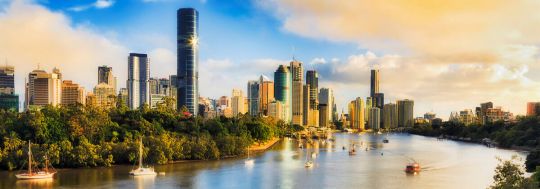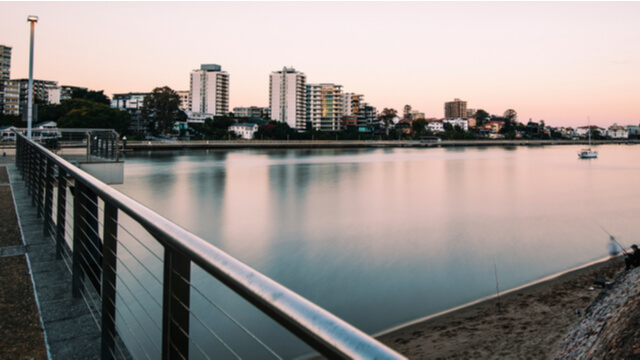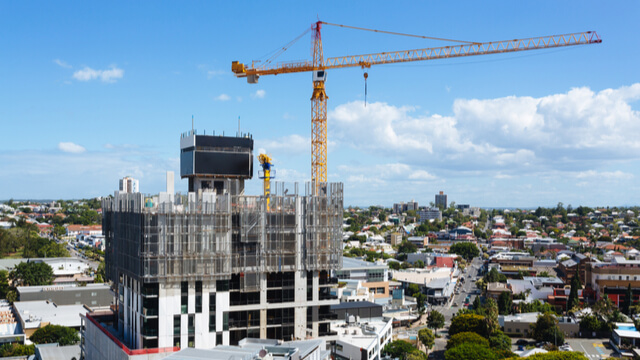Buying an apartment in Brisbane – what to look out for

If you’re on the hunt for a Brisbane apartment that ticks all the boxes, here are some points you may wish to consider.
Where in Brisbane should you buy an apartment?
Deciding which region or suburb of Brisbane you want to buy in is an important first step in narrowing down your options. Two significant factors which could influence your decision are cost and liveability.
Regarding cost, here are the median unit prices for Brisbane’s four regions as of September 2019, according to Domain:
- East – $414,000
- North – $378,550
- South – $394,000
- West – $440,000
When it comes to liveability, here are some of Brisbane’s most lifestyle-friendly suburbs as calculated by Realestate.com.au, based on factors including transit times to the CBD and proximity to the river, schools, and parks. Their median unit prices as of November 2019, according to Realestate.com.au, have also been included, where available.
- South Brisbane – $475,000
- Dutton Park – $411,000
- Spring Hill – $413,500
- Kangaroo Point – $460,000
- Corinda – $420,000
- Indooroopilly – $465,000
- Fortitude Valley – $388,500
- Petrie Terrace – N/A
- West End – $512,000
- New Farm – $530,000

- Proximity to the Brisbane river can be a major factor when calculating a suburb’s liveability. Credit: robdowner (Shutterstock)
How much do apartments in Brisbane cost?
As of September 2019, Brisbane’s median unit price was $375,179 according to Domain, making Brisbane’s unit market the fourth-most affordable of Australia’s capital cities.
However, median prices fluctuate by suburb and area, and these fluctuations can be significant. Looking at the suburbs listed above as an example, there’s a difference of just over $140,000 between the cheapest and most expensive suburbs on the list.
With this in mind, you may want to do your research and figure out which suburbs have median unit prices that fall within a price range you can afford. It may also be worth seeking the advice of a property market expert if you feel it’s necessary.
Compare Home Loans (First home buyer with a variable rate) with Canstar
If you’re currently considering a home loan, the comparison table below displays some of the variable rate home loans on our database with links to lenders’ websites that are available for first home buyers. This table is sorted by Star Rating (highest to lowest), followed by comparison rate (lowest-highest). Products shown are principal and interest home loans available for a loan amount of $500,000 in NSW with an LVR of 80% of the property value and that offer an offset account. Consider the Target Market Determination (TMD) before making a purchase decision. Contact the product issuer directly for a copy of the TMD. Use Canstar’s home loans comparison selector to view a wider range of home loan products. Canstar may earn a fee for referrals.
The comparison rate for all home loans and loans secured against real property are based on secured credit of $150,000 and a term of 25 years.
^WARNING: This comparison rate is true only for the examples given and may not include all fees and charges. Different terms, fees or other loan amounts might result in a different comparison rate.
 Owner occupied
Owner occupied
 5% min deposit
5% min deposit
 Redraw facility
Redraw facility
 Owner occupied
Owner occupied
 20% min deposit
20% min deposit
 Redraw facility
Redraw facility
 Owner occupied
Owner occupied
 20% min deposit
20% min deposit
 Redraw facility
Redraw facility
 Owner occupied
Owner occupied
 5% min deposit
5% min deposit
 Redraw facility
Redraw facility
 Owner occupied
Owner occupied
 5% min deposit
5% min deposit
 Redraw facility
Redraw facility
Canstar is an information provider and in giving you product information Canstar is not making any suggestion or recommendation about a particular product. If you decide to apply for a home loan, you will deal directly with a financial institution, not with Canstar. Rates and product information should be confirmed with the relevant financial institution. Home Loans in the table include only products that are available for somebody borrowing 80% of the total loan amount. For product information, read our detailed disclosure, important notes and additional information. *Read the comparison rate warning. The results do not include all providers and may not compare all the features available to you.
Home Loan products displayed above that are not “Sponsored or Promoted” are sorted as referenced in the introductory text followed by Star Rating, then lowest Comparison Rate, then alphabetically by company. Canstar may receive a fee for referral of leads from these products.
When you click on the button marked “Enquire” (or similar) Canstar will direct your enquiry to a third party mortgage broker. If you decide to find out more or apply for a home loan, you can provide your details to the broker. You will liaise directly with the broker and not with Canstar. When you click on a button marked “More details” (or similar), Canstar will direct your enquiry to the product provider. Canstar may earn a fee for referral of leads from the comparison table above. See How We Get Paid for further information.
What are the pros and cons of choosing a Brisbane apartment as an investment?
The merit of choosing a Brisbane apartment as an investment option may depend on several factors, including your risk tolerance and the timeframe in which you’re hoping to see a return on your investment.
As previously mentioned, data from Domain has revealed that the September quarter saw Brisbane’s median unit prices down by 3.40% quarter-on-quarter and 5.60% year-on-year. However, the October 2019 Residential Report from BIS Oxford Economics is forecasting a 14% increase in value for Brisbane units by 2022.
Additionally, you may be able to generate more immediate cash returns if you buy in the right suburb at the right time. Property research firm and buyer’s agency Propertyology identified five Brisbane suburbs that can generate a positive pre-tax cash flow – Blackstone, Redbank, Springfield Lakes, Bray Park, and Bracken Ridge – and you may find that there are others in the Greater Brisbane region.
If you’re not sure if investing in an apartment in Brisbane is the right move for you, you may want to consult with a financial adviser or property expert for guidance.
Is Brisbane’s apartment market over or under-supplied?
The Real Estate Institute of Queensland said in September that Brisbane’s unit market is in the process of bouncing back from a prolonged period of oversupply, while data from BIS Oxford Economics also shows that oversupply is slowly but surely being reduced by rental demand.
Figures from PRDnationwide suggest the number of Brisbane apartments due to be completed in 2019 will be up by 70% compared to 2018. However, it is unknown whether this boost to supply will be met by a boost to demand.

- Figures suggest the number of apartments built in Brisbane in 2019 is set to be significantly higher than 2018. Credit: Pawel Papis (Shutterstock)
Should I buy an existing Brisbane apartment or off-the-plan?
The question of whether or not you should buy an off-the-plan apartment in Brisbane is a personal one, but there are a few risks, benefits, and key pieces of information you may want to keep in mind when considering this option.
- CoreLogic data for August revealed that 43.1% of Queensland’s off-the-plan units were worth less at settlement than what their owners originally purchased them for.
- Fifty-eight of Brisbane’s 102 high-rise projects approved since 2009 had not yet begun construction as of August 2019, according to BCI.
- As of April 2019, half of all Brisbane off-the-plan apartments sold in the past eight years had lost money on resale, according to BIS Oxford Economics.
While the above information doesn’t automatically make buying an off-the-plan apartment in Brisbane a bad option for you, you may want to seek the advice of a property expert or financial advisor before jumping in.
Investing in an apartment or a house?
In order to decide whether you want to invest in a house or an apartment in Brisbane, you may wish to consider the area(s) in which you’re considering buying and the time-frame in which you’re hoping to see significant capital growth.
According to data from Domain, in the September quarter, Brisbane’s median house value decreased by 1% quarter-on-quarter and 1.8% year-on-year, whereas the city’s median unit value decreased by significantly more as mentioned previously, falling by 3.4% quarter-on-quarter and 5.6% year-on-year.
That being said, BIS Oxford Economics is predicting that, while it considers houses to be a relatively ‘safe bet’ when it comes to property investment in Brisbane, apartments in certain locations will likely outperform the housing market in the long term.
Before committing to investing in either a house or an apartment, it may be prudent to consider your personal circumstances and investment goals, and let them inform your final decision.
Can my choice of suburb affect the long-term value of my apartment?
Research from Propertyupdate.com.au supports the idea that, generally speaking, suburbs which are closer to the city centre and a river or beach tend to outperform suburbs which are further out and further away from water.
Propertyupdate.com.au also identifies the following suburbs as strong performers, where it predicts prices will continue to rise into the future:
- Keperra
- Chermside West
- Cannon Hill
- Ashgrove
Will you be able to afford the cost of living in Brisbane?
This year’s Worldwide Cost of Living survey from the Economist Intelligence Unit dropped Brisbane 15 places to 41st on the list, making it the third-most expensive Australian capital city on the list after Melbourne (22nd) and Sydney (16th).
The rankings were based on the prices of food, clothing, rent, transport, utility bills, private school fees, domestic help and recreational costs in each city considered.
Your ability to afford the cost of living in Brisbane as a home owner will depend on several factors, including your personal financial circumstances and the serviceability of your home loan.
If you’re concerned about finding a home loan that’s right for you, you can start your search with Canstar.
[bs_button size=”lg” type=”primary” value=”Compare Home Loans” href=”/home-loans/”]
The comparison rate for all home loans and loans secured against real property are based on secured credit of $150,000 and a term of 25 years.
^WARNING: This comparison rate is true only for the examples given and may not include all fees and charges. Different terms, fees or other loan amounts might result in a different comparison rate.
 Owner occupied
Owner occupied
 20% min deposit
20% min deposit
 Redraw facility
Redraw facility
Canstar may earn a fee for referrals from its website tables, and from Sponsorship or Promotion of certain products. Fees payable by product providers for referrals and Sponsorship or Promotion may vary between providers, website position, and revenue model. Sponsorship or Promotion fees may be higher than referral fees. Sponsored or Promoted products are clearly disclosed as such on website pages. They may appear in a number of areas of the website such as in comparison tables, on hub pages and in articles. Sponsored or Promoted products may be displayed in a fixed position in a table, regardless of the product’s rating, price or other attributes. The table position of a Sponsored or Promoted product does not indicate any ranking or rating by Canstar. For more information please see How We Get Paid.
Cover image source: Taras Vyshnya/Shutterstock.com

- Where in Brisbane should you buy an apartment?
- How much do apartments in Brisbane cost?
- What are the pros and cons of choosing a Brisbane apartment as an investment?
- Is Brisbane’s apartment market over or under-supplied?
- Should I buy an existing Brisbane apartment or off-the-plan?
- Investing in an apartment or a house?
- Can my choice of suburb affect the long-term value of my apartment?
- Will you be able to afford the cost of living in Brisbane?
The comparison rate for all home loans and loans secured against real property are based on secured credit of $150,000 and a term of 25 years.
^WARNING: This comparison rate is true only for the examples given and may not include all fees and charges. Different terms, fees or other loan amounts might result in a different comparison rate.
 Owner occupied
Owner occupied
 30% min deposit
30% min deposit
 Redraw facility
Redraw facility
Try our Home Loans comparison tool to instantly compare Canstar expert rated options.
The comparison rate for all home loans and loans secured against real property are based on secured credit of $150,000 and a term of 25 years.
^WARNING: This comparison rate is true only for the examples given and may not include all fees and charges. Different terms, fees or other loan amounts might result in a different comparison rate.





